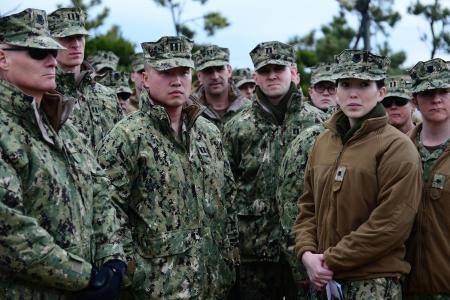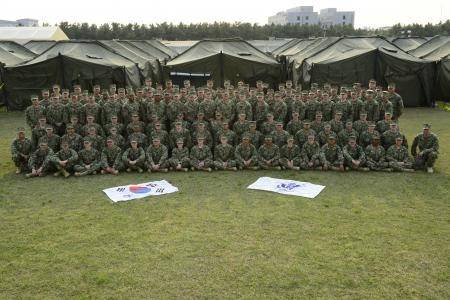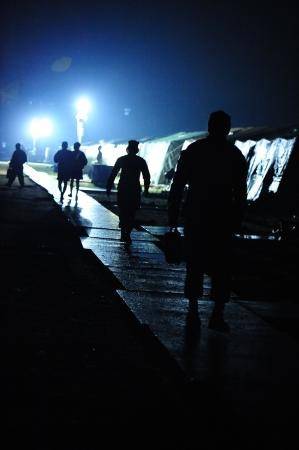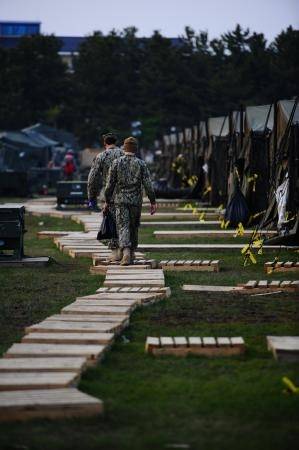Life at Camp Baldwin: Pohang, South Korea
With air temperatures hovering around freezing every night, steaming hot showers were a welcomed luxury for more than 1,200 deployed Coast Guard, Army, Navy, Marine and Air Force personnel at Camp Baldwin, especially once the camp was transformed into a giant mud pit after steady rain showers drenched the clay grounds during the day.
Camp Baldwin, a large-scale, temporary military camp built in the middle of a Korean Marine base in Pohang, South Korea, housed the participants of the Combined Joint Logistics Over the Shore Exercise (CJLOTS), an annual exercise comprised of more than 1,200 U.S. military personnel from 43 commands working in conjunction with the Republic of Korea’s military forces.
“This was my first deployment,” said Coast Guard Petty Officer 2nd Class Carla Galland. “I was really excited when I heard we were going to Korea. I thought to myself, ‘Yay! I get to go some place I actually know!”
Galland, a U.S. citizen born in Seoul, South Korea, when her father was in the U.S. Army stationed at Yongsan Army Base. Galland’s heritage and childhood trips to South Korea helped prepare her for the unpredictable spring weather, common to the peninsula.
“I knew the weather would be hot and cold with drastic changes in temperature,” said Galland. “However, I wasn’t expecting [the weather] to be as schizophrenic as it was. It changed drastically in a really short period of time.”
Despite Galland’s military heritage, living in a large-scale, temporary military camp designed to support thousands of personnel was a new experience for her. Senior PSU members were more experienced.
“I’ve deployed six times to a variety of countries, so it’s very familiar to me,” said Cmdr. Daniel Clark, PSU 313’s commanding officer. “Picture a family camping trip with 1,200 people who are all working together in a foreign place. They might not speak the same language, the environment seems extreme, and we’re forced to keep strange hours. It’s dirty and uncomfortable, but the expeditionary nature of it is really essential.”
PSUs are designed to be self-sufficient for 30 days in support of Coast Guard and operational commanders worldwide. This is vital during natural disasters when there is no supporting infrastructure like during the Haitian Earthquake and Hurricane Katrina.
Overall, accommodations at Camp Baldwin were satisfactory due to the tireless efforts of a crew of U.S. Navy Seabees from Coronado, Calif.
“When it’s all said and done it will be two full months from arrival to departure for my crew,” said Navy Chief Petty Officer Martin Villalpando, the camp czar, charged with managing camp construction and maintenance. “Most of these Seabees come from battalions where we do eight or nine month deployments to Iraq and Afghanistan- so two months is pretty easy to a lot of these guys.”
Villalpando said he and his crew spent about ten days prior to the exercise constructing more than 1,800 pieces of decking (wooden sidewalks), assembling more than 85 berthing tents, and establishing a power grid to keep electricity running throughout the camp.
“This is largest expeditionary camp I’ve experienced, and the Navy Seabee’s and Army’s 501st Sustainment Brigade did an incredible job together building and maintaining the camp,” said Clark. “I know my whole crew appreciated everything that was here for them.”
Despite the amenities, Coast Guard Port Security Units (PSUs) are unique reserve commands designed to be self-sufficient, regardless of pre-existing infrastructure.
“Be it in the field for a deployment or responding to a natural disaster, Coast Guard men and women adapt to the situation,” said Clark. “Winds constantly shifting, below freezing temperatures in our tents- none of it impeded the crews ability to get the job done. They continued to work, achieve and complete the mission even in light of adversity and that’s the most amazing piece- the people who do the mission.”




















